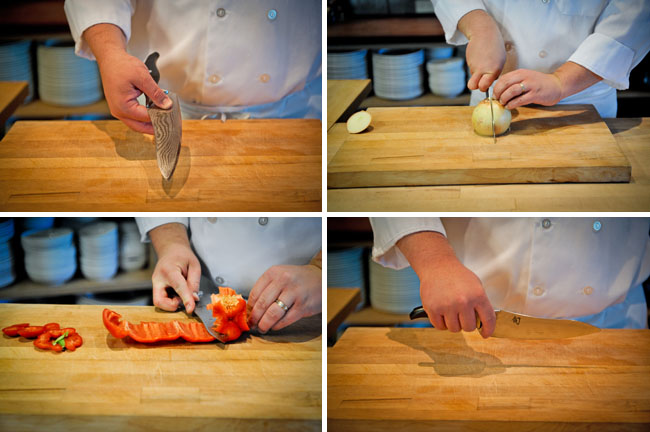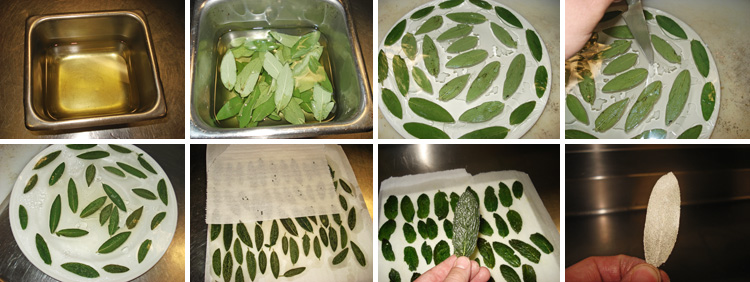How To Pick Out A Chef's Knife That's Right For You

Choosing the right chef's knife is one of the most important decisions you’ll make when equipping your kitchen. Your chef’s knife is the number one tool you’ll constantly and consistently use. My advise is not to skimp and try and get off cheap.
You really don’t need any number of those crazy tools and gadgets that you see displayed at your local kitchen store. Avocado slicers, tomato dicer; what’s this, a lettuce knife? Please!
I like having gizmo’s and gadgets just as much as the next guy, but when it comes down to it, you only need two knives: a 10” chef’s knife and a 6-7” utility knife.
Why Only Two Knives?
When I first enrolled in culinary school, I was ecstatic to find $2,500 of my $55,000 dollar tuition would be put towards an extensive tool kit, including about 15 different knives. A couple months later when I begged my way into one of the best fine dining restaurants in San Francisco as an apprentice, I realized I really only needed two knives; a 10” chef’s knife and a 6” utility knife.
The first day I showed up, I brought my entire knife roll with me into their extremely small kitchen. After all, I didn’t know any better, I was nothing more than some amateur who’d been watching Emeril bam all over the screen and make all sorts of money and I thought to myself, “I can do this.” So I ask the poor shlup who was assigned to baby-sit me where I could put my knives.
“You don’t. Put your knife roll upstairs with the lockers, and bring down your chef’s knife and your pairing knife,” he said with understandable annoyance.
This is how I found out the hard way, and with much embarrassment, you really only need two knives in your kitchen, a Chef’s knife (preferably 10”) and a pairing knife. As I progressed forward with my skills but still understood the importance of minimizing my knife selection, I traded in my pairing knife for a 6.5” Utility knife. Here’s why:
My 10” chef’s knife is my go to blade when I need to slice, dice, mince, julienne or batonnet, but it becomes a little arduous when fabricating meat or performing more delicate cuts. Although at first it may seem a little awkward using a utility knife in place of a pairing knife, with practice it can be done.
I also use my utility knife for all the major meat fabrication I do on a regular basis, including breaking down and de-boning chickens, fabricating beef tenderloins into filets, and cleaning and portioning fish. Quite honestly, with a little practice and proper technique, your chef’s knife and utility knife will be able to handle 95% or more of your average workload. But knowing the secret that you only really need two knives in your kitchen isn’t enough. To make this secret work, you need to know how to choose a knife that’s right for you.
What To Look For in A Knife
When I go out to buy a new knife, no matter if it’s a chef’s knife, utility knife, or just a knife for fun, these are the three main things that I take into consideration; steel, handle and weighting.
The Steel
The first thing you need to address is what kind of steel you want. This is commonly overlooked when buying a knife but it should play an important role in your decisions once you understand the two major differences.
Although there are many types of knives manufactured by different companies using numerous kinds of steel alloys, your decision will pretty much come down to two choices: German Steel or Japanese Steel.
German knives are characterized by traditionally having a little bit of a thicker blade as compared to Japanese knives. This makes them a little more sturdy and less prone to breaking off a tip when dropped (which can and will happen). German knives are also traditionally sharpened to about a 22° angle, making them sharp but also sturdy.
German Knife Pros:
-
Sturdy and strong.
-
Hold their edge for a good amount of time
-
Easy to sharpen
German Knife Cons:
-
Thicker blade makes delicate cuts more difficult, such as slicing sashimi for sushi, or the fine julienne and Brunoise of vegetables.
Japanese knives on the other hand have a more delicate composition with a thinner blade that is usually sharpened to an 18-16° angle. This extreme edge makes them impressively sharp, but they don’t stay sharp quite as long. They’re also a little bit more difficult to sharpen.
Japanese Pros:
-
Sharpened to an extreme angle which makes them razor sharp.
-
Great for more delicate cuts such as sushi and fine vegetable work.
Japanese Cons:
-
Tend to be a little more difficult to sharpen than German knives.
-
Because they are sharpened to such an extreme angle, their edge is a little more fragile and won’t hold for quite as long. (There are some exceptions to this rule).
The Handle
When choosing a knife, you want to take into careful consideration the type of handle the knife has. It should comfortably fit the type and size of your hand. If you have a smaller hand, you’re going to want to buy a knife with a thinner handle. Conversely, if you have a larger hand, you'll need to purchase a knife with a wider handle. Someone with a larger hand who uses a thin handled knife will develop pressure points in the palm of their hand. This will tense their grip, leading to poor fluidity of movement and inaccurate cuts.
The key to having good knife skills is a knife you can hold with a relaxed and comfortable grip for an extended period of time.
Weighting
Finally, the third and final aspect you need to take into consideration when purchasing a knife is the overall weighting. But remember, don’t confuse weighting with weight. Too often I hear people bragging about how nice and light their chef’s knife is. “Hey, check this knife out, it’s light as a feather!”
Who cares? It’s not like your curling a 50-pound dumb bell every time you pick up a chef’s knife! What really matters is how the weight is distributed throughout the knife, or the "balance."
For longer knives, such as the 10” chef’s knife or a long slicer, the balance point should be right where the blade connects to the handle, meaning the blade and the handle are of about equal weight. The shorter the blade gets (such as a three inch pairing knife), the more handle heavy the knife will be. This will give you greater control over the confined and intricate movements you will inherently be making with a shorter blade.
Chef Knives I Recommend
Further Information
-
Watch our entire HD video series on knife skills.
-
Listen to SCS 1| Basic Knife Skills


